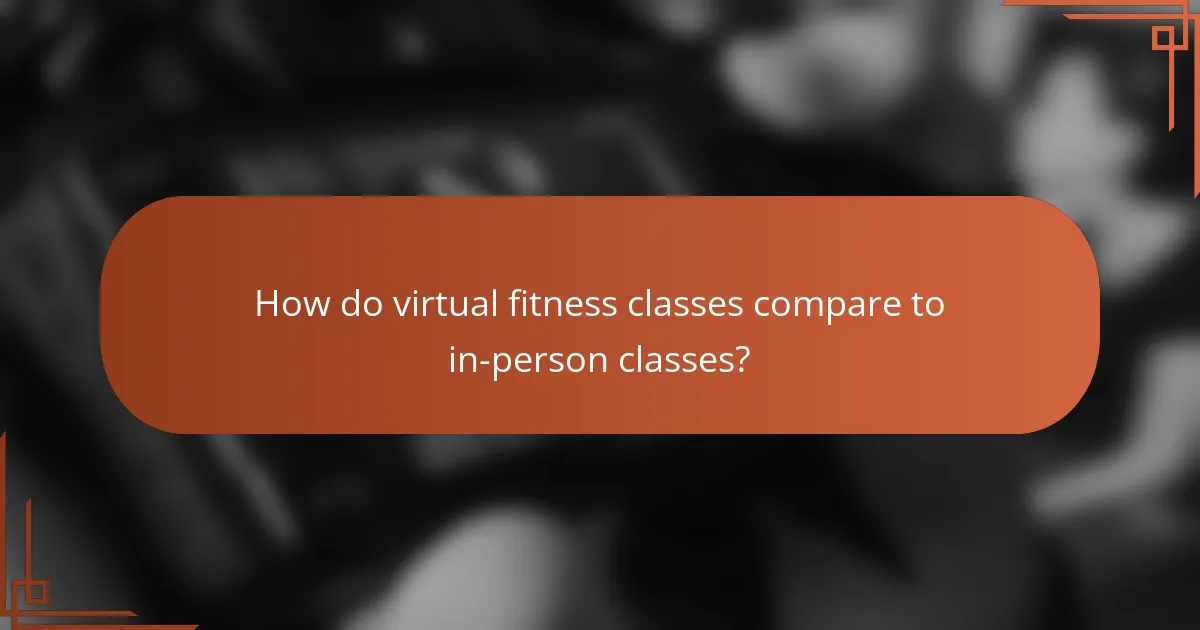Virtual fitness classes are revolutionizing the way individuals engage with their workouts, fostering a sense of community and motivation through interactive experiences. By utilizing advanced technology, these classes not only connect participants with instructors but also enhance the overall fitness journey. Fitness trackers play a crucial role in this ecosystem, offering real-time feedback and performance tracking to help users optimize their workouts and stay committed to their goals.

How do virtual fitness classes enhance engagement in Canada?
Virtual fitness classes significantly enhance engagement in Canada by offering interactive experiences that connect participants with instructors and fellow attendees. These classes leverage technology to create a dynamic environment that motivates users to stay committed to their fitness goals.
Interactive features
Interactive features in virtual fitness classes, such as live polls, chat functions, and video conferencing, foster a sense of participation among users. These tools allow participants to ask questions in real time, share their progress, and receive instant encouragement from instructors and peers.
For example, platforms may include gamification elements like leaderboards or challenges that encourage friendly competition. This not only boosts motivation but also keeps users engaged throughout the session.
Community building
Community building is a crucial aspect of virtual fitness classes, as it helps participants feel connected despite physical distances. Many platforms facilitate group discussions, social media integration, and member forums where users can share experiences, tips, and support.
In Canada, local fitness communities often organize group challenges or events that encourage participation and camaraderie. This sense of belonging can lead to increased retention rates and a more enjoyable fitness journey.
Real-time feedback
Real-time feedback during virtual fitness classes allows participants to adjust their techniques and improve performance immediately. Instructors can provide personalized advice based on participants’ movements, ensuring that everyone is performing exercises safely and effectively.
Additionally, many fitness apps offer metrics tracking, enabling users to monitor their progress over time. This data can motivate individuals to push themselves further and celebrate their achievements, enhancing overall engagement in their fitness routines.
![]()
What are the best fitness trackers for virtual classes?
The best fitness trackers for virtual classes enhance your workout experience by providing real-time feedback, tracking your performance, and integrating seamlessly with various fitness apps. Key features to consider include heart rate monitoring, GPS functionality, and compatibility with popular virtual fitness platforms.
Fitbit Charge 5
The Fitbit Charge 5 is a versatile fitness tracker that excels in virtual class integration. It offers built-in GPS, heart rate monitoring, and a vibrant display, making it easy to follow along with workouts. Its compatibility with the Fitbit app allows users to access a variety of virtual classes and track their progress over time.
One standout feature is the Daily Readiness Score, which helps you determine if your body is ready for a workout or needs recovery. This can be particularly useful for planning your virtual fitness sessions effectively.
Garmin Venu 2
The Garmin Venu 2 is designed for those who prioritize both fitness tracking and smart features. It includes a bright AMOLED display and offers a wide range of preloaded workouts, including yoga, strength training, and cardio, which can be followed during virtual classes. Its advanced health monitoring features provide insights into your overall wellness.
With the Garmin Connect app, users can join live classes and track their performance metrics in real-time. The battery life is impressive, lasting up to 11 days in smartwatch mode, making it suitable for extended use without frequent recharging.
Apple Watch Series 8
The Apple Watch Series 8 stands out for its seamless integration with the Apple ecosystem and a wide array of fitness apps. It features advanced health monitoring capabilities, including blood oxygen and ECG readings, which can enhance your understanding of your fitness levels during virtual workouts. The large, always-on display makes it easy to follow along with classes.
Additionally, the Apple Fitness+ service provides access to a variety of virtual classes led by professional trainers. The watch’s ability to sync with your iPhone allows for easy tracking of your workouts and progress, making it a comprehensive tool for fitness enthusiasts.
![]()
How do fitness trackers improve workout experiences?
Fitness trackers enhance workout experiences by providing real-time data and insights that help users optimize their performance and stay motivated. They offer personalized feedback, track progress towards goals, and integrate with various fitness applications for a comprehensive approach to health and fitness.
Personalized metrics
Fitness trackers collect personalized metrics such as heart rate, calories burned, and activity levels, allowing users to tailor their workouts to their specific needs. This data helps individuals understand their physical limits and adjust their routines accordingly for better results.
For example, a user can monitor their heart rate during different exercises to ensure they are training within their target zone, which can enhance fat burning or improve cardiovascular fitness. Many devices also allow users to set thresholds for alerts, ensuring they stay within safe limits.
Goal tracking
Goal tracking is a key feature of fitness trackers, enabling users to set and monitor specific fitness objectives. Whether aiming to run a certain distance, lose weight, or complete a set number of workouts each week, these devices provide feedback on progress.
Users can establish short-term and long-term goals, with many trackers offering reminders and motivational messages to keep them engaged. Regularly reviewing progress can help users stay accountable and make necessary adjustments to their fitness plans.
Integration with apps
Fitness trackers often integrate seamlessly with various fitness and health applications, enhancing the overall user experience. This integration allows users to sync their data with platforms that offer additional insights, community support, and personalized coaching.
Popular apps like MyFitnessPal or Strava can provide comprehensive analytics on nutrition and performance, while social features enable users to connect with friends for challenges and motivation. This interconnectedness not only enriches the workout experience but also fosters a sense of community among users.
![]()
What features should you look for in a fitness tracker?
When choosing a fitness tracker, focus on features that enhance your workout experience and engagement, such as heart rate monitoring, GPS functionality, and battery life. These elements can significantly impact your ability to track progress and stay motivated during virtual fitness classes.
Heart rate monitoring
Heart rate monitoring is essential for understanding your workout intensity and overall cardiovascular health. Look for trackers that provide real-time heart rate data, allowing you to adjust your effort during virtual classes. Many devices offer features like heart rate zones, which help you optimize your training.
Consider trackers that use optical sensors for continuous heart rate tracking, as they tend to be more accurate than those that require manual input. Aim for a device that can alert you if your heart rate exceeds or drops below a certain threshold, ensuring you stay within safe limits.
GPS functionality
GPS functionality is crucial for outdoor workouts, allowing you to track distance, pace, and route. A fitness tracker with built-in GPS can provide accurate data without needing to carry your smartphone. This feature is particularly beneficial for running, cycling, or hiking, where knowing your location and distance is key.
When selecting a tracker, check the GPS accuracy and how quickly it locks onto satellites. Some devices offer additional features like route mapping and elevation tracking, which can enhance your outdoor fitness experience.
Battery life
Battery life is a vital consideration, especially if you engage in long workouts or multi-day activities. Look for fitness trackers that offer at least several days of battery life on a single charge, particularly if you plan to use GPS frequently. Some models may provide extended battery life in power-saving modes.
Keep in mind that features such as continuous heart rate monitoring and GPS usage can drain the battery faster. Choose a tracker that allows you to customize settings based on your activity level to maximize battery performance.

How do virtual fitness classes compare to in-person classes?
Virtual fitness classes offer a different experience compared to in-person classes, primarily in terms of accessibility and engagement. While both formats can provide effective workouts, the choice often depends on personal preferences and lifestyle needs.
Flexibility and convenience
Virtual fitness classes provide unmatched flexibility, allowing participants to join sessions from anywhere at any time. This convenience is particularly beneficial for those with busy schedules or family commitments, as it eliminates travel time and allows for workouts to fit seamlessly into daily routines.
For example, many platforms offer on-demand classes, enabling users to select workouts that suit their availability, whether early in the morning or late at night. This adaptability can significantly increase adherence to fitness goals.
Cost-effectiveness
Virtual fitness classes tend to be more cost-effective than in-person alternatives. Many online platforms offer subscription models that can range from low monthly fees to annual memberships, often significantly lower than traditional gym memberships.
Additionally, participants save on transportation costs and can avoid extra fees for specialized classes. This financial accessibility makes it easier for a broader audience to engage in regular fitness activities.
Access to diverse instructors
Virtual fitness classes provide access to a wide range of instructors from various backgrounds and expertise levels. This diversity allows participants to explore different styles and methodologies, enhancing their overall fitness experience.
For instance, users can easily switch between yoga, high-intensity interval training, or dance classes led by experts from around the world. This variety not only keeps workouts fresh but also helps individuals find instructors whose teaching styles resonate with them, fostering better engagement and motivation.

What are the challenges of virtual fitness classes?
Virtual fitness classes face several challenges that can impact user experience and engagement. Key issues include technical difficulties, lack of personal interaction, and motivation hurdles that can affect participants’ commitment to their fitness goals.
Technical issues
Technical issues are a primary challenge for virtual fitness classes, often manifesting as connectivity problems, software glitches, or hardware limitations. Participants may experience lag, poor video quality, or audio disruptions, which can hinder their ability to follow along with the instructor effectively.
To mitigate these issues, ensure a stable internet connection with a speed of at least 5 Mbps for smooth streaming. Using wired connections instead of Wi-Fi can also reduce latency. Regularly updating software and using compatible devices can help avoid common technical pitfalls.
It’s also wise to have a backup plan, such as a recorded session, in case of significant technical failures. This way, participants can still access the workout at their convenience, maintaining their fitness routine despite potential live session challenges.